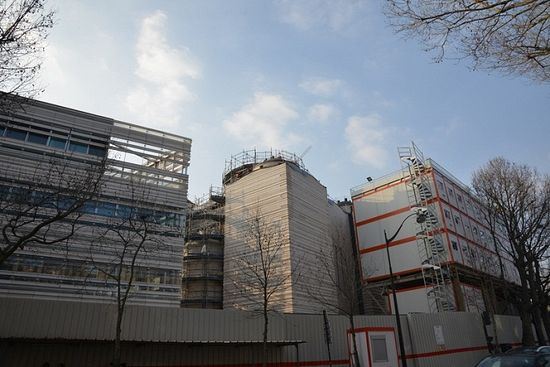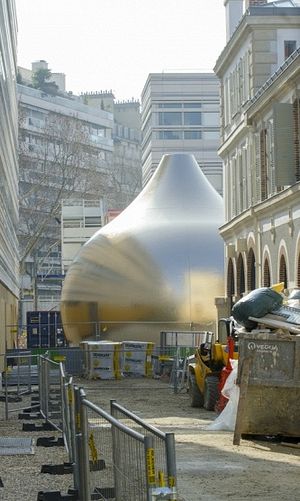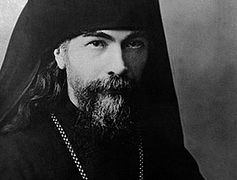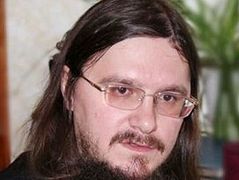Source: TASS
Paris, March 14, 2016
The construction of a Russian Orthodox cathedral is nearing completion in Paris with its domes to be mounted on Saturday, March 19.
The cathedral will be part of the Cultural and Spiritual Russian Orthodox Center located on Quai Branly near the Eiffel Tower. It will incorporate a French-Russian primary school for 150 school students, a library, exhibition halls, premises of an Orthodox parish and a seminary.
“This compound has become a project for all Parisians,” says the mayor of District 7 where construction is underway, Rachida Dati, also France’s representative at the European Parliament. “This is not only a symbol of faith, but also a monument that will be of great artistic value”.
The land plot alone is worth 70 to 75 million euro
The facility with a total area of 4,200 square kilometers is built on the territory of the former French meteorological service Meteo-France.
Russia bought the land plot on the left bank of the Seine in 2010, sources from the mayor’s office told Tass. Terms of the deal were confidential. Experts put the cost of the land plot in this historic district of Paris at about 70-75 million euro. As for the cost the cultural and spiritual center, experts say it will be clear after the construction is completed.
The contract for the construction of the center was signed in 2011, in the presence of Russian President Vladimir Putin and the then French Prime Minister, Francois Fillon.
Traditions and modern times
According to District 7 Mayor Rachida Dati, the authors of the project faced a difficult task to integrate the new building into the historical architectural landscape. The district boasts palaces, museums and the Eiffel Tower that are on the UNESCO’s World Heritage List.
The choice of the project took several years. In 2011, Spanish architect Manuel Nunez Yanowsky won the contest with his architectural model, but it did not satisfy the Paris Mayoral Office. City authorities thought the project as it was would be out of tune with the urban context.
The final option was approved in January 2014. It was designed by famous French architect Jean-Michel Wilmotte, renowned for restauration of the College de France in Paris’s Quartier Latin and the famous Rijksmuseum in Amsterdam.
In his project, Wilmotte managed to harmonize traditions and modern trends.
Major French construction group Bouygues was tasked with construction work. Its head, Martin Bouygues, said it was “an honor to participate in such a major project of international importance”. “We will exert every effort to see it become an absolute and undisputable success for Russia and France,” the businessman pledged.
Burgundy limestone, which was also used in the construction of the Louvre and Notre Dame, was chosen for the historic project.
Construction is to be completed in summer 2016. “A new Orthodox church on the left bank of the Seine will be inaugurated this year,” Russian Ambassador to France Alexander Orlov said.
Event of tremendous importance for the Orthodox community in France
The idea to build the center dates back to the mid-2000s. Back then it became clear that the Russian diocese had grown sizably and needed a new church that would be a center of attraction of the Russian Orthodox Church after restoration of canonical unity in 2007.
According to Rachida Dati, the Orthodox church has made an outstanding contribution to world culture. “As realized by Europeans, it is associated exactly with Russia, along with great Russian literature, music and theater,” she said.
According to ruling Bishop Nestor of the Diocese of Korsun of the Russian Orthodox Church, Orthodoxy has been present in France from the 19th century. “Remarkable representatives of Russian emigration, renowned theologians who opened Orthodoxy to French people have lived there,” he said.
He said the life of parishes became increasingly active of late. “Diaspora-related processes are under way, probably exceeding the events we had before by their scope and importance,” the diocesan said. “We constantly feel we must meet the spiritual needs of the people who visit the countries of the Diocese of Korsun. These demands are constantly growing, and we make every effort so that these people don’t feel cut off from their native culture,” he said.
According to the hierarch, the opening of the Russian spiritual and cultural center Paris is a tremendous in its importance event in the life of the Orthodox society in France.
Monument to those who died for France’s freedom
The new church will be a monument to the Russian people who gave their lives for France’s freedom. One hundred years ago, at the height of the WWI battle of Verdun, which was crucial for France, Russia came to the rescue. In March 1916, the Russian army launched an offensive on the Eastern Front. The Lake Naroch Offensive helped ease pressure on France, albeit killing or wounding 78,000 Russians. Germany had to urgently redeploy divisions from East Prussia and Belgium to the Russian front, while initially planning to use them at Verdun.
A month later, the first brigade of the Russian Expeditionary Force, sent at the request of France to participate in warfare on the Western Front, arrived in Marseille after a 70-day sea passage from the Far East.
“Our soldiers came to the rescue to their ally. They died for freedom of France,” Alexander Orlov said.
After the 1917 February revolution in Russia, the unit was disbanded, but hundreds of volunteers continued their service among French troops. “Their valiance earned the Russian soldiers the title of ‘the Legion of Honor’,” French historian Jean-Pierre Arrignon marked.
“Long live the friendship of Russia and France!”
The dialogue between France and Russia has never stopped throughout modern history. Visiting Moscow in the summer of 1966, French President General Charles de Gaulle ended his famous address to Muscovites with an emotional peroration in Russian – “Long live Moscow!”, “Long live Russia!”, “Long live the friendship of Russia and France!”
The new center is intended to become yet another link between France and Russia. Symbolically, it will be located right next to Avenue Franco-Russe.





